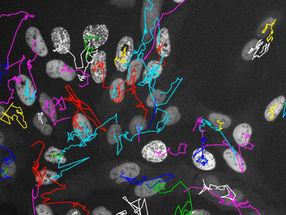A ranking of environmental chemicals
How dangerous are environmental chemicals and what is their effect on human health? In a project funded by the Austrian Science Fund FWF, the pharmacist Daniela Schuster is currently developing a computer-based "early warning system" for potentially dangerous substances.
In our daily lives we are exposed to a great variety of environmental chemicals found in cleaning substances, cosmetics, plastic products, textiles or food supplements. Many of these synthetic products leave traces in our bodies and are known to have an impact on our immune system, hormonal balance or cardio-vascular system. Within the context of the European Union's REACH programme and the US National Toxicity Programme, chemicals are systematically screened for their potentially harmful impact. The pharmacist Daniela Schuster is developing methods designed to vastly improve the efficiency and precision of these tests. In her work at the Institute of Pharmacy at the University of Innsbruck, the researcher benefits from her experience with drug discovery and development applying the methods used in this field.
Simulation of effects and side effects
In order to investigate the action mechanisms in chemicals, Schuster developed so-called pharmacophore-based computer models. She uses 3D models to simulate where and how substances come in contact with the human body and what side effects they may have. "Computer-based predictions about the potential toxicity of chemicals are extremely valuable for further tests in the lab or in humans. Based on these predictions we can assess which chemicals are most likely to have a biological effect and prioritise them for testing", explains Schuster.
Hormone focus shows frist results
Together with her team and international partners, Daniela Schuster is developing a screening platform based on the principle of the "pharmacophore model" in an ongoing FWF project. The individually built models are cross-checked against databases that list environmental chemicals. The screening enables the scientists to identify potentially toxic "candidates". The researchers then procure those chemicals on the list with particularly high production volumes and with which human beings come into direct contact so as to conduct further testing.
The researchers in this new project derive high expectations from the fact that their tests involve enzymes responsible for hormone production whose potentially harmful effects have hardly ever been investigated so far. "We already have some very interesting results", reports Schuster from the ongoing project. "It has been shown, for instance, that parabens impede oestrogen degradation. This means they could foster the growth of oestrogen-dependent tumours", explains the scientist. Parabens are preservatives often used in cosmetics, but additionally in food. "We have also discovered some vanillin derivatives that can increase the oestrogen level", Schuster adds. This type of flavouring substance is found in chewing gum, for instance. According to Schuster, the first tests of the pilot study showed that some food colourings also had the potential to influence the oestrogen level.
Prediction platform enhances safety
The computer-based early warning system developed by the researchers from Innsbruck has the advantage of enabling experts to work in a more targeted manner and perform more tests. Apart from the early warning system for potentially dangerous substances, the system will also be able to list compounds that have turned out to be harmless. "We use an exclusion procedure, which means we can wave the harmless ones through quite quickly. That is an advantage of the computer model in combination with the lab tests", emphasises Schuster. Above all, the method is an important tool for the future so as to enable additional predictions to be made. The screening platform the team developed and the case studies generated on this basis are to lay the foundations for further systematic studies. "It would be desirable to have more comprehensive official regulations about which tests need to be performed in order for chemicals to be accepted as safe", says Schuster about one goal she is pursuing with her basic research. Prior to that, however, the relevance for the human body of the individual mechanisms has to be identified, and the number of candidates here is huge.
Most read news
Organizations
Other news from the department science

Get the life science industry in your inbox
By submitting this form you agree that LUMITOS AG will send you the newsletter(s) selected above by email. Your data will not be passed on to third parties. Your data will be stored and processed in accordance with our data protection regulations. LUMITOS may contact you by email for the purpose of advertising or market and opinion surveys. You can revoke your consent at any time without giving reasons to LUMITOS AG, Ernst-Augustin-Str. 2, 12489 Berlin, Germany or by e-mail at revoke@lumitos.com with effect for the future. In addition, each email contains a link to unsubscribe from the corresponding newsletter.





















































